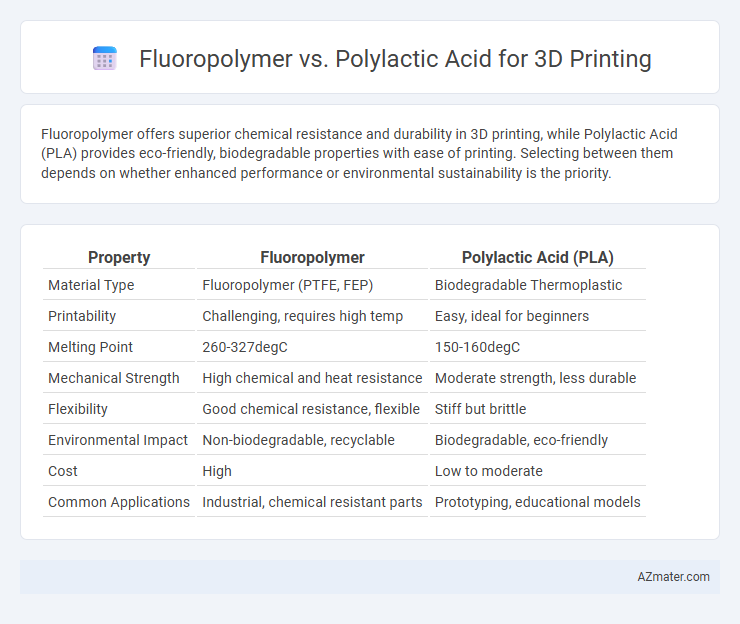Fluoropolymer offers superior chemical resistance and durability in 3D printing, while Polylactic Acid (PLA) provides eco-friendly, biodegradable properties with ease of printing. Selecting between them depends on whether enhanced performance or environmental sustainability is the priority.
Table of Comparison
| Property | Fluoropolymer | Polylactic Acid (PLA) |
|---|---|---|
| Material Type | Fluoropolymer (PTFE, FEP) | Biodegradable Thermoplastic |
| Printability | Challenging, requires high temp | Easy, ideal for beginners |
| Melting Point | 260-327degC | 150-160degC |
| Mechanical Strength | High chemical and heat resistance | Moderate strength, less durable |
| Flexibility | Good chemical resistance, flexible | Stiff but brittle |
| Environmental Impact | Non-biodegradable, recyclable | Biodegradable, eco-friendly |
| Cost | High | Low to moderate |
| Common Applications | Industrial, chemical resistant parts | Prototyping, educational models |
Introduction to Fluoropolymer and Polylactic Acid in 3D Printing
Fluoropolymers in 3D printing offer exceptional chemical resistance, thermal stability, and low friction properties, making them ideal for industrial applications requiring durability and high-performance materials. Polylactic Acid (PLA) is a biodegradable thermoplastic derived from renewable resources like corn starch, favored for its ease of use, low warping, and environmental sustainability in desktop 3D printing. The choice between fluoropolymer and PLA depends on the specific requirements for mechanical strength, environmental impact, and printing complexity.
Material Properties Comparison: Fluoropolymer vs Polylactic Acid
Fluoropolymer materials exhibit exceptional chemical resistance, high-temperature stability up to 260degC, and low friction coefficients, making them ideal for demanding 3D printing applications requiring durability and inertness. Polylactic Acid (PLA) offers biodegradability, ease of printing at lower temperatures around 180-220degC, and good tensile strength but lacks thermal and chemical resistance compared to fluoropolymers. The choice between fluoropolymer and PLA hinges on the need for high-performance material properties versus eco-friendly, cost-effective printing options.
Printability and Ease of Use
Fluoropolymers offer excellent chemical resistance and high-temperature stability but present challenges in 3D printing due to their high melting points and low surface energy, requiring specialized equipment and printing conditions. Polylactic Acid (PLA) excels in printability with a low melting temperature around 180-220degC, minimal warping, and broad compatibility with most FDM printers, making it ideal for beginners and rapid prototyping. Ease of use favors PLA as it enables consistent layer adhesion and smooth finishes without advanced temperature controls or specialized bed surfaces, unlike fluoropolymers that often demand heated chambers and adhesives for successful prints.
Mechanical Strength and Durability
Fluoropolymers exhibit exceptional mechanical strength and chemical resistance, making them highly durable for demanding 3D printing applications subjected to harsh environments. Polylactic Acid (PLA) offers moderate strength and biodegradability but tends to be more brittle and less heat-resistant, limiting its durability under mechanical stress. Fluoropolymers outperform PLA in longevity and performance, especially where flexibility and resistance to wear and chemicals are critical.
Chemical Resistance and Environmental Stability
Fluoropolymers exhibit exceptional chemical resistance against acids, bases, and solvents, making them highly suitable for 3D printing applications requiring durable exposure to harsh chemicals. Polylactic acid (PLA) offers moderate chemical resistance but degrades significantly when exposed to moisture, UV radiation, and elevated temperatures, affecting its environmental stability. Fluoropolymers maintain dimensional stability and mechanical integrity in extreme conditions, whereas PLA is biodegradable yet less stable, limiting its use in chemically demanding environments.
Biodegradability and Sustainability Factors
Fluoropolymers, known for their chemical resistance and durability, are non-biodegradable and pose environmental challenges due to their persistence in ecosystems. Polylactic Acid (PLA), derived from renewable resources like corn starch, offers excellent biodegradability and compostability, making it a sustainable choice for eco-friendly 3D printing. PLA's lower environmental footprint and ability to decompose under industrial composting conditions significantly enhance its appeal for sustainable manufacturing compared to petroleum-based fluoropolymers.
Cost Efficiency and Material Availability
Fluoropolymer offers excellent chemical resistance and high-temperature stability but comes at a higher cost and limited availability compared to Polylactic Acid (PLA), which is widely accessible and budget-friendly for most 3D printing applications. PLA's biodegradability and ease of printing make it a cost-efficient choice for prototyping and consumer projects, while fluoropolymer's expense restricts its use to specialized industrial purposes. Material availability favors PLA due to extensive manufacturer support and global distribution, ensuring lower procurement costs and faster supply chains.
Applications in Industry and Prototyping
Fluoropolymers offer exceptional chemical resistance, high-temperature stability, and low friction, making them ideal for industrial applications requiring durable and inert components such as piping, seals, and medical devices. Polylactic Acid (PLA), a biodegradable and easy-to-print thermoplastic, is favored in prototyping due to its cost-effectiveness, environmental friendliness, and ability to produce detailed models rapidly. While fluoropolymers excel in demanding functional parts, PLA dominates early-stage prototype development where material sustainability and printability are prioritized.
Post-Processing and Surface Finish
Fluoropolymers in 3D printing provide exceptional chemical resistance and smooth, low-friction surface finishes, requiring minimal post-processing to maintain their inherent non-stick qualities. Polylactic Acid (PLA) offers easier post-processing options such as sanding, acetone vapor smoothing, and painting, but typically results in a less durable surface finish prone to scratches and environmental degradation. Choosing between fluoropolymer and PLA depends on the application demands for surface durability versus ease of finishing and biodegradability.
Choosing the Right Material for Your 3D Printing Needs
Fluoropolymers offer exceptional chemical resistance, high-temperature stability, and low friction, making them ideal for functional parts requiring durability and exposure to harsh environments. Polylactic acid (PLA) is biodegradable, easy to print with, and environmentally friendly, best suited for prototyping, educational purposes, and detailed aesthetic models. Selecting the right material depends on the application's mechanical demands, environmental exposure, and sustainability goals to optimize print performance and end-use functionality.

Infographic: Fluoropolymer vs Polylactic Acid for 3D Printing
 azmater.com
azmater.com